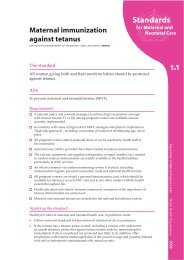1uvZ4zN
1uvZ4zN
1uvZ4zN
You also want an ePaper? Increase the reach of your titles
YUMPU automatically turns print PDFs into web optimized ePapers that Google loves.
Volume III<br />
Foreword<br />
This volume builds upon the previous volumes analysis of the past to begin to point the<br />
way forward for national unity, healing and reconciliation. One cannot speak of national<br />
unity, healing and reconciliation without discussing ethnic tension. The causes of ethnic<br />
tension, and the problems raised by ethnic tension, have been discussed in other parts of<br />
this Report. In particular the chapter on ethnic tension should be read together with the<br />
chapter on Economic Marginalization and Violations of Socio-Economic Rights.<br />
Ethnic tensions, particularly the tendency to view people who are different as ‘the other’<br />
and thus not identify with, and either fear or scapegoat them, is unfortunately as old as<br />
human history. Tracing the origins of ethnic tension in Kenya to the beginning of history<br />
was beyond the scope of the Commission’s work. To understand the continued presence<br />
of ethnic tension today, and its evolution during our mandate period, we started with the<br />
colonial period, for it was under the colonial power that the political entity today known<br />
as Kenya was formed. In discussing ethnic tension since independence, we look at state<br />
and non-state actors, including the role of culture and stereotypes. Any discussion of<br />
ethnic tension in present-day Kenya would be incomplete without a discussion of the<br />
relationship between ethnicity and politics. It is an unfortunate fact that who joins a<br />
political party, and which politicians or parties form alliances, can be more often explained<br />
by ethnicity over any other factor. It is this potent, and at times volatile, combination of<br />
ethnicity and politics that has unfortunately spiralled into ethnic violence far too many<br />
times in our history.<br />
While ethnicity and ethnic tension are discussed throughout the Report, we include here<br />
a case study on Mt. Elgon to provide a deeper analysis of the history of ethnicity in Kenya<br />
and its relationship to politics, land, and violence. The Mt. Elgon case study is unique<br />
because of the peculiar mix of ethnicity in the region, and the fact that ethnic tensions<br />
gave rise to a well-organized militia that terrorized the local population, which in turn<br />
led the state to engage in a military operation to stop the militia, but which also resulted<br />
in additional violations of the local population. Yet, the story of Mt. Elgon is typical in<br />
that it combines aspects of historical injustices that the Commission had seen in many<br />
other parts of the country. Firstly, the use of ethnicity to divide a local community and<br />
the combining of ethnic tension with disputes over land. Secondly, ethnic tension over<br />
land and identity spilling over into overt violence. Thirdly, the creation of organized<br />
militia groups to harden tensions based upon land and ethnicity. Fourthly, the influence<br />
of all of these forces on the political dynamics of the region, underscored by the role that<br />
REPORT OF THE TRUTH, JUSTICE AND RECONCILIATION COMMISSION<br />
iii






